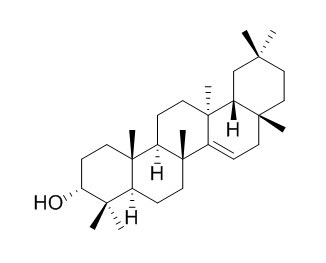Epitaraxerol
Epitaraxerol shows moderate antifungal activity against C. albicans and low antimicrobial activity against T. mentagrophytes, A. niger, S. aureus, E. coli, P. aeruginosa, and B. subtilis.
Inquire / Order:
manager@chemfaces.com
Technical Inquiries:
service@chemfaces.com
Tel:
+86-27-84237783
Fax:
+86-27-84254680
Address:
1 Building, No. 83, CheCheng Rd., Wuhan Economic and Technological Development Zone, Wuhan, Hubei 430056, PRC
Providing storage is as stated on the product vial and the vial is kept tightly sealed, the product can be stored for up to
24 months(2-8C).
Wherever possible, you should prepare and use solutions on the same day. However, if you need to make up stock solutions in advance, we recommend that you store the solution as aliquots in tightly sealed vials at -20C. Generally, these will be useable for up to two weeks. Before use, and prior to opening the vial we recommend that you allow your product to equilibrate to room temperature for at least 1 hour.
Need more advice on solubility, usage and handling? Please email to: service@chemfaces.com
The packaging of the product may have turned upside down during transportation, resulting in the natural compounds adhering to the neck or cap of the vial. take the vial out of its packaging and gently shake to let the compounds fall to the bottom of the vial. for liquid products, centrifuge at 200-500 RPM to gather the liquid at the bottom of the vial. try to avoid loss or contamination during handling.
Pak J Pharm Sci.2019, 32(6)
Int J Mol Sci.2019, 21(1):E265
ACS Synth Biol.2022, doi: 10.1021.
Analytical Letters.2020, doi 10.1008
Mol Cancer Ther.2024, 1535-7163.
Korean J of Crop Science2019, 452-458
Reprod Toxicol.2020, 96:1-10.
LWT2024, v208:116677
Pharmaceuticals (Basel).2022, 15(8):982.
J Pharmacopuncture.2023, 26(4):357-365.
Related and Featured Products
Pharmacognosy Journal, 2012, 4(31):1-4.
Chemical constituents of Broussonetia luzonicus[Reference:
WebLink]
METHODS AND RESULTS:
The leaves of Broussonetia luzonicus afforded Epitaraxerol (1), lupenone (2), squalene (3), β-carotene (4), vitamin K (5) and β-sitosterol (6), while the flowers yielded 2, 6, lupeol (7), betulin aldehyde fatty acid ester (8) and lupeol fatty acid ester (9). The compounds were isolated by silica gel chromatography and identified by NMR spectroscopy. Triterpenes 1, 2 and 8 were tested for cytotoxicity using the MTT assay. They did not exhibit cytotoxic effect against a human cancer cell line colon carcinoma (HCT 116).
CONCLUSIONS:
Results of the antimicrobial tests on 1, 2 and 8 indicated moderate antifungal activity against C. albicans and low antimicrobial activity against T. mentagrophytes, A. niger, S. aureus, E. coli, P. aeruginosa, and B. subtilis.
Zhong Yao Cai. 2009 Sep;32(9):1390-2.
Studies on the chemical constituents from Euphorbia chrysocoma[Pubmed:
20034213]
To study the chemical constituents from the aerial part of Euphorbia chrysocoma.
METHODS AND RESULTS:
All compounds were isolated and purified by many methods, including siliga gel and reversed phase RP-18 column chromatographies, preparative thin layer chromatography, Sephadex LH-20, and recrystallization. Their structures were mainly elucidated by ESI-MS and NMR spectra and their physical characters. Six compounds were isolated from the petroleum ether section from 75% ethanol extraction of the material. Their structures were identified as taraxerol (1), Epitaraxerol (2), beta-sistosterol (3), beta-sitostenone (4), jolkinolide E (5), and sesamin (6).
CONCLUSIONS:
Compounds 1, 2, 4, 5, and 6 are isolated from this plant for the first time.



